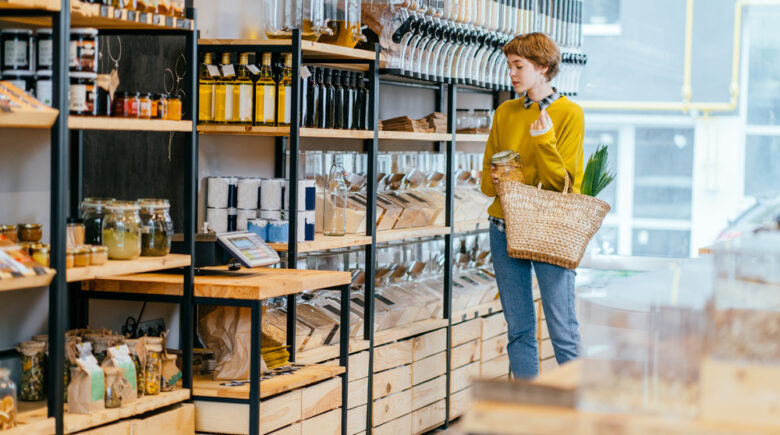Sustainable shopping has become an effective tool for people to help create a greener future in a society that is becoming more aware of its environmental impact. Every purchase we make has an effect that extends beyond our shopping carts. We can work together to pressure effective change and promote a more environmentally friendly world by understanding the significance of sustainable purchasing and learning how to make educated decisions.
Effects of Consumer Decisions
The choices made by consumers significantly impact how fit our world becomes. Every purchase affects the environment, from food to technology to clothing and household goods. A few effects of mindless consumption include unsustainable production processes, unnecessary packaging, and resource depletion. We can lessen these dreadful effects and advance a sustainable future by being informed consumers.
Giving Eco-Friendly and Ethical Brands Priority
A crucial component of sustainable shopping is backing companies emphasizing sustainability and ethical behavior. Make sure the companies you love are in line with your ideals by researching them. Will they work to reduce their carbon footprint? Do they employ moral hard labor habits and renewable resources? Using online resources and apps, you can identify and choose manufacturers who share your commitment to a greener future.
Regional and Seasonal Eating
Supporting local organizations and consuming seasonal foods can significantly reduce the carbon footprint caused by transportation and garage. Locally produced goods no longer only support the network but also use less energy during transport. Consuming in-season foods lessens the need for out-of-season produce, frequently necessitating energy-intensive greenhouse growing or long-distance transportation. Minimizing Packaging Waste Excessive packaging is a significant source of waste in the world today. When purchasing, look for items with less or recyclable packaging. Bulk purchasing enables you to buy products in larger quantities while utilizing your reusable containers, an excellent method to reduce packaging waste. This not only lessens packaging waste but also eventually saves you money.
Supporting Flea Markets and Vintage Shops
Accepting vintage shopping and antique markets may be a fun and eco-friendly way to update your home and wardrobe. Pre-owned items reduce environmental impact by extending product lifespans and keeping them out of landfills. Examining used possibilities decreases the need for brand-new products and supports a circular economy, whether it is for clothing, furniture, or technology.
The Influence of Mindful Consumption
Conscious consumption has become popular in a generation characterized by increased environmental awareness. By doing this, you support businesses that stress sustainability and moral behavior and connect your purchases with your values. You can tell companies that sustainability is essential by using your purchasing power. Businesses are encouraged to modify their processes to satisfy customer demands for environmentally friendly and ethically manufactured goods. Understanding how our alternatives affect society and the environment is another aspect of conscious consumption. It knows about ethical business practices, human rights, and animal welfare. You may avoid supporting businesses that exploit employees or harm the environment by researching a company’s supply chain and production methods.
Technology’s Place in Sustainable Shopping
Era is crucial in advancing sustainable shopping behaviors in the present virtual world. Customers can access a multitude of information about a product’s environmental impact, ethical issues, and certifications through mobile apps and internet services. These technologies enable users to make informed selections in real-time, even as they browse the aisles of a store. For instance, transparent supply chains are built using blockchain technology, allowing customers to follow a product’s journey from the manufacturer to the store shelf. This enables the verification and accuracy of sustainability and moral behavior claims. Customers may visualize how a product might fit into their lives before purchasing, thanks to augmented reality (AR) packages, which lower the risk of impulse purchases and consequent waste.
Slow Fashion: A Transition from Fast Fashion
The fashion business is notorious for its social and environmental implications, often due to the growing trend of rapid fashion. Fast fashion encourages the mass production of inexpensive, throwaway apparel, adding to enormous volumes of textile waste and abusing people’s labor in underdeveloped nations. Although buyers and architects are embracing the sluggish style motion, the trend is turning. Slow fashion encourages purchasing timeless, enduring, and ethically manufactured apparel by prioritizing quality over quantity. It promotes openness throughout the supply chain and honors craftsmanship. Remember to prioritize natural, sustainable fabrics and versatile pieces that may be mixed and matched when shopping for clothing. Consider renting, trading, or buying used to lessen the need for new clothing creation.
The Future of Packaging: Environmentally Friendly Advances
Environmental friendliness is prioritized in the innovative solutions being used to address the issue of excessive packaging waste. Packaging is evolving sustainably, including things like biodegradable materials and simple designs. Brands are embracing compostable packaging made from seaweed and cornstarch, which decompose quickly and reduce pollution. The sale of “bare” goods, which come in no packaging at all, is another new trend. This technique reduces trash and motivates customers to use reusable bins. Additionally, some companies are experimenting with packaging that is safe to eat and allows you to eat the package while holding the product. Customers may support firms who prioritize lowering their packaging footprint as sustainable packaging gets popularity.
Conclusion
Sustainable purchasing is a robust way for people to contribute to a better future. We can work together to drive successful change and promote a more sustainable future by understanding the impact of consumer choices, emphasizing ethical and green companies, and embracing conscious buying habits. By making thoughtful decisions, we can use every purchase as a vote for a brighter future and open the door to a healthy planet for future generations. So let’s be sensible with our money, think about sustainability, and move toward a better, greener future. Sustainable purchasing is not always a fad but a crucial component of our journey toward a more environmentally friendly end. We can all work together to build a more just and sustainable society by promoting conscious consumerism, utilizing technology, embracing slower fashion, and supporting innovative packaging solutions.
Sustainable shopping has become an effective tool for people to help create a greener future in a society that is becoming more aware of its environmental impact. Every purchase we make has an effect that extends beyond our shopping carts. We can work together to pressure effective change and promote a more environmentally friendly world by understanding the significance of sustainable purchasing and learning how to make educated decisions.
Effects of Consumer Decisions
The choices made by consumers significantly impact how fit our world becomes. Every purchase affects the environment, from food to technology to clothing and household goods. A few effects of mindless consumption include unsustainable production processes, unnecessary packaging, and resource depletion. We can lessen these dreadful effects and advance a sustainable future by being informed consumers.
Giving Eco-Friendly and Ethical Brands Priority
A crucial component of sustainable shopping is backing companies emphasizing sustainability and ethical behavior. Make sure the companies you love are in line with your ideals by researching them. Will they work to reduce their carbon footprint? Do they employ moral hard labor habits and renewable resources? Using online resources and apps, you can identify and choose manufacturers who share your commitment to a greener future.
Regional and Seasonal Eating
Supporting local organizations and consuming seasonal foods can significantly reduce the carbon footprint caused by transportation and garage. Locally produced goods no longer only support the network but also use less energy during transport. Consuming in-season foods lessens the need for out-of-season produce, frequently necessitating energy-intensive greenhouse growing or long-distance transportation. Minimizing Packaging Waste Excessive packaging is a significant source of waste in the world today. When purchasing, look for items with less or recyclable packaging. Bulk purchasing enables you to buy products in larger quantities while utilizing your reusable containers, an excellent method to reduce packaging waste. This not only lessens packaging waste but also eventually saves you money.
Supporting Flea Markets and Vintage Shops
Accepting vintage shopping and antique markets may be a fun and eco-friendly way to update your home and wardrobe. Pre-owned items reduce environmental impact by extending product lifespans and keeping them out of landfills. Examining used possibilities decreases the need for brand-new products and supports a circular economy, whether it is for clothing, furniture, or technology.
The Influence of Mindful Consumption
Conscious consumption has become popular in a generation characterized by increased environmental awareness. By doing this, you support businesses that stress sustainability and moral behavior and connect your purchases with your values. You can tell companies that sustainability is essential by using your purchasing power. Businesses are encouraged to modify their processes to satisfy customer demands for environmentally friendly and ethically manufactured goods. Understanding how our alternatives affect society and the environment is another aspect of conscious consumption. It knows about ethical business practices, human rights, and animal welfare. You may avoid supporting businesses that exploit employees or harm the environment by researching a company’s supply chain and production methods.
Technology’s Place in Sustainable Shopping
Era is crucial in advancing sustainable shopping behaviors in the present virtual world. Customers can access a multitude of information about a product’s environmental impact, ethical issues, and certifications through mobile apps and internet services. These technologies enable users to make informed selections in real-time, even as they browse the aisles of a store. For instance, transparent supply chains are built using blockchain technology, allowing customers to follow a product’s journey from the manufacturer to the store shelf. This enables the verification and accuracy of sustainability and moral behavior claims. Customers may visualize how a product might fit into their lives before purchasing, thanks to augmented reality (AR) packages, which lower the risk of impulse purchases and consequent waste.
Slow Fashion: A Transition from Fast Fashion
The fashion business is notorious for its social and environmental implications, often due to the growing trend of rapid fashion. Fast fashion encourages the mass production of inexpensive, throwaway apparel, adding to enormous volumes of textile waste and abusing people’s labor in underdeveloped nations. Although buyers and architects are embracing the sluggish style motion, the trend is turning. Slow fashion encourages purchasing timeless, enduring, and ethically manufactured apparel by prioritizing quality over quantity. It promotes openness throughout the supply chain and honors craftsmanship. Remember to prioritize natural, sustainable fabrics and versatile pieces that may be mixed and matched when shopping for clothing. Consider renting, trading, or buying used to lessen the need for new clothing creation.
The Future of Packaging: Environmentally Friendly Advances
Environmental friendliness is prioritized in the innovative solutions being used to address the issue of excessive packaging waste. Packaging is evolving sustainably, including things like biodegradable materials and simple designs. Brands are embracing compostable packaging made from seaweed and cornstarch, which decompose quickly and reduce pollution. The sale of “bare” goods, which come in no packaging at all, is another new trend. This technique reduces trash and motivates customers to use reusable bins. Additionally, some companies are experimenting with packaging that is safe to eat and allows you to eat the package while holding the product. Customers may support firms who prioritize lowering their packaging footprint as sustainable packaging gets popularity.
Conclusion
Sustainable purchasing is a robust way for people to contribute to a better future. We can work together to drive successful change and promote a more sustainable future by understanding the impact of consumer choices, emphasizing ethical and green companies, and embracing conscious buying habits. By making thoughtful decisions, we can use every purchase as a vote for a brighter future and open the door to a healthy planet for future generations. So let’s be sensible with our money, think about sustainability, and move toward a better, greener future. Sustainable purchasing is not always a fad but a crucial component of our journey toward a more environmentally friendly end. We can all work together to build a more just and sustainable society by promoting conscious consumerism, utilizing technology, embracing slower fashion, and supporting innovative packaging solutions.



